
Naturally occurring iris species of the ussr
Bearded iris
A characteristic feature which determines the name of these iris is the presence of a "beard", a hairy growth at the base of the falls of the flowers.
Ten species of the bearded iris are found wild in the USSR. Of these Iris germanica is the most important. In 1753 Carl Linnaeus used the cultivated plants of this species to describe the genus Iris. This is a rare species which is to be carefully protected. The 50-to 70 cm stalk carries from 3 to 5 large flowers of dark or pale violet-blewish colour with a reddish shade, and each branch usually bears one flower.
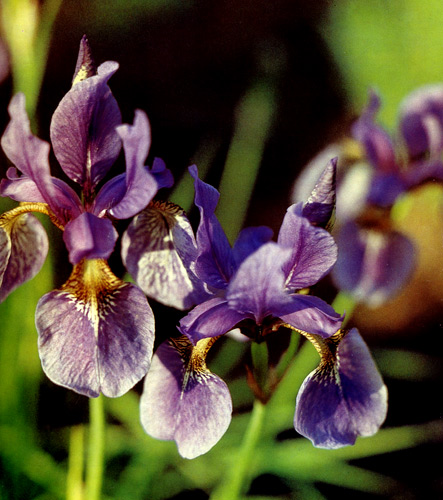
31. Iris sibirica
The cultivated varieties of the horticultural bearded iris are traditionally referred to as varieties of Iris germanica. It should be remembered, however, that modern cultivars of the so-called Iris germanica were developed by crossing 8 iris species, i.e. Iris germanica, pallida, variegata, aphylla, cypriana, mesopotamica, trojana and kaschmiriana. Therefore, it is more correct to call them cultivars of the garden, or hybrid iris.
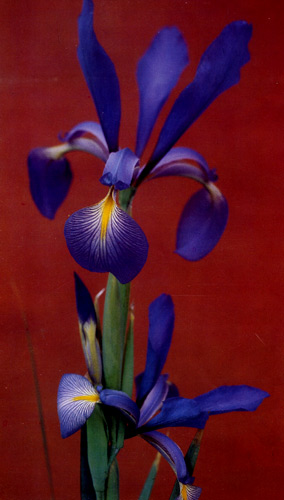
32. 'Lenkoran' (Spuria)
Beside Iris germanica, two more progenitors of garden bearded iris occur in the USSR, Iris variegata and Iris aphylla.
Once widely spread in the south-west regions of the USSR, Iris variegata is on the verge of extinction. It can be still found in the forest glades, at the edges of oak forests, on stony scarps in Moldavia and the Ukraine. The stalks 45 to 60cm tall carry 3 to 5 carmine-red and golden-yellow flowers. They seem to radiate gaiety, and this is reflected even in the names of cultivars originating from this species ('Gay Hussar', 'Gay Head').

'Moldova'(Spuria)
The iris with a strange name "Aphylla" with a small, 20 to 35 cm stalk, branching at the base, and bright violet flowers is found in the wild in the steppe and forest-steppe regions of the European part of the USSR, in Transcaucasia and the Central part of the montane belt in Armenia and Georgia. In late autumn the foliage dies and in spring it appears later than the flower stalks. It is an extremely important biological feature to complete vegetation early. Many valuable cultivars of the hybrid iris die out in trials in the northern regions as they do not complete vegetation by autumn. Iris aphylla is a progenitor of a large group of cultivars similar to 'Black Forest' and others belonging to the Intermediate group.
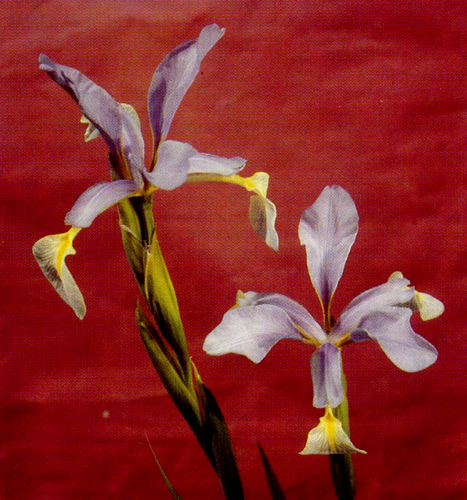
34. Iris klattii
Up to now two interesting tall mountaneous iris of our flora have not been involved in extensive hybridization.
One of them, is Iris albertii with purple violet flowers, grows near the high-mountaneous Medeo skating rink. The second one, Iris imbricata, with greenish-yellow flowers is most common on the stony slopes in Armenia and south-east regions in Azerbaijan. Genetically, the two species are relatives. They are readily crossed on the experimental plots of the Leningrad Botanical Garden and produce seedlings with a more vigorous clump compared to the parents. The rhizomes of Iris albertii are resistant to bacteriosis, the most injurous disease of the bearded iris. The two species are early flowering and highly frost-resistant.
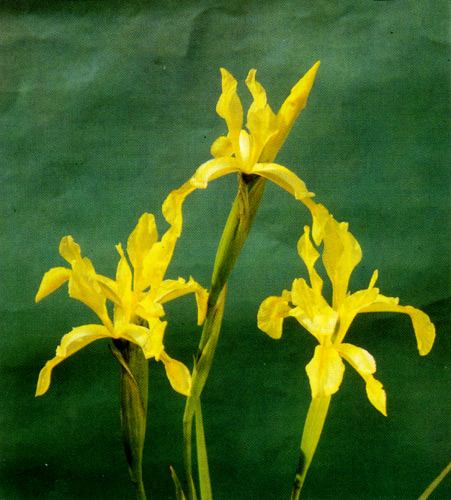
35. Iris halophila
The main progenitor of the dwarf bearded iris is Iris pumila. It is an interesting species both scientifically and practically. This interspecific hybrid possesses a double set of chromosomes in the cells. Due to its high viability I. pumila is found throughout a vast range extending from Central Europe into the southern spurs of the Urals.
Iris pumila is distinguished by an extremely polychromatic pattern. The flowers can be white, pink, yellow, reddish violet, and dark violet with nearly a black shade. Numerous forms of this species are presented in the rare collection of G.T. Shevchenko at the Stavropol Botanical Garden.

36. 'Kurlen'
The pollen of I. pumila shows increased activity and is able to produce superlong pollen tubes. In the 1950s in Western Europe and the USA where fanciers of dwarf iris set up a specialized society, many hybrids were obtained through crosses of Iris pumila with different species and cultivars of both tall and intermediate bearded iris, and forms from Oncocyclus and Regelia sections.
Nowadays Iris pumila is subject to strict protection. The seeds may be collected. Autumn-sown seeds show uniform germination. The seedlings start blooming in the second year.
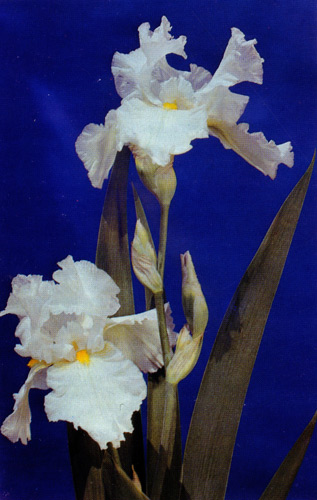
37. 'Purga'
|
ПОИСК:
|
© FLOWERLIB.RU 2001–2022
При использовании материалов активная ссылка обязательна:
http://flowerlib.ru/ 'Библиотека по цветоводству'
При использовании материалов активная ссылка обязательна:
http://flowerlib.ru/ 'Библиотека по цветоводству'